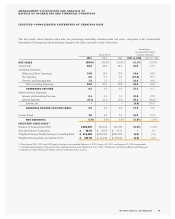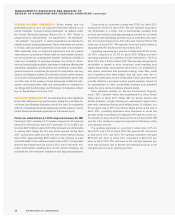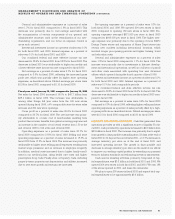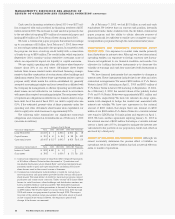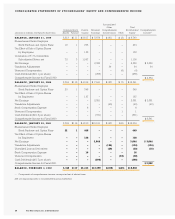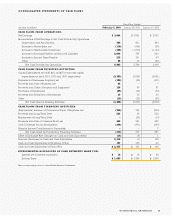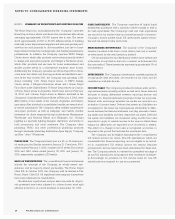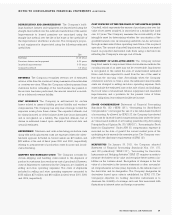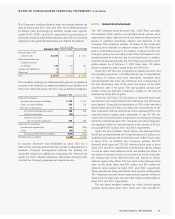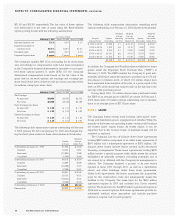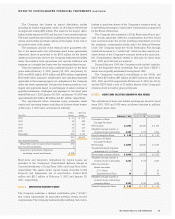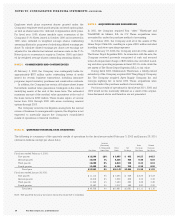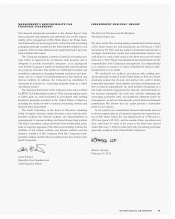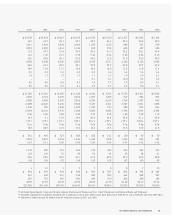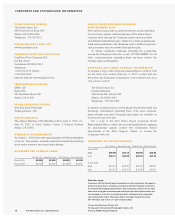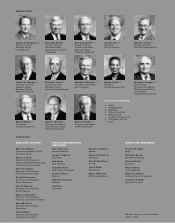Home Depot 2001 Annual Report Download - page 31
Download and view the complete annual report
Please find page 31 of the 2001 Home Depot annual report below. You can navigate through the pages in the report by either clicking on the pages listed below, or by using the keyword search tool below to find specific information within the annual report.
NOTES TO CONSOLIDATED FINANCIAL STATEMENTS (CONTINUED)
29The Home Depot, Inc. and Subsidiaries
COST IN EXCESS OF THE FAIR VALUE OF NET ASSETS ACQUIRED
Goodwill, which represents the excess of purchase price over fair
value of net assets acquired, is amortized on a straight-line basis
over 40 years. The Company assesses the recoverability of this
intangible asset by determining whether the amortization of the
goodwill balance over its remaining useful life can be recovered
through undiscounted future operating cash flows of the acquired
operation. The amount of goodwill impairment, if any, is measured
based on projected discounted cash flows using a discount rate
reflecting the Company’s average cost of funds.
IMPAIRMENT OF LONG-LIVED ASSETS The Company reviews
long-lived assets for impairment when circumstances indicate the
carrying amount of an asset may not be recoverable. Impairment
is recognized to the extent the sum of undiscounted estimated
future cash flows expected to result from the use of the asset is
less than the carrying value. Accordingly, when the Company
commits to relocate or close a store, the estimated unrecoverable
costs are charged to selling and store operating expense. Such
costs include the estimated loss on the sale of land and buildings,
the book value of abandoned fixtures, equipment and leasehold
improvements, and a provision for the present value of future
lease obligations, less estimated sublease income.
STOCK COMPENSATION Statement of Financial Accounting
Standards No. 123 (“SFAS 123”), “Accounting for Stock-Based
Compensation”encourages the use of a fair-value-based method
of accounting. As allowed by SFAS 123, the Company has elected
to account for its stock-based compensation plans under the intrin-
sic value-based method of accounting prescribed by Accounting
Principles Board Opinion No. 25 (“APB 25”), “Accounting for Stock
Issued to Employees.”Under APB 25, compensation expense is
recorded on the date of grant if the current market price of the
underlying stock exceeds the exercise price. The Company com-
plies with the disclosure requirements of SFAS 123.
DERIVATIVES On January 29, 2001, the Company adopted
Statement of Financial Accounting Standards Nos. 133, 137,
and 138 (collectively “SFAS 133”), “Accounting for Derivative
Instruments and Hedging Activities.”SFAS 133 requires an entity to
measure derivatives at fair value and recognize these assets or lia-
bilities on the balance sheet. Recognition of changes in the fair
value of a derivative in the income statement or other accumulat-
ed comprehensive income (loss) depends on the intended use of
the derivative and its designation. The Company designates its
derivatives based upon criteria established by SFAS 133. The
Company’s objective for holding derivative instruments is to
decrease the volatility of earnings and cash flow associated with
fluctuations in interest rates and foreign currencies.
DEPRECIATION AND AMORTIZATION The Company’s build-
ings, furniture, fixtures and equipment are depreciated using the
straight-line method over the estimated useful lives of the assets.
Improvements to leased premises are amortized using the
straight-line method over the life of the lease or the useful life of
the improvement, whichever is shorter. The Company’s proper-
ty and equipment is depreciated using the following estimated
useful lives:
Life
Buildings 10-45 years
Furniture, fixtures and equipment 5-20 years
Leasehold improvements 5-30 years
Computer software 3-5 years
REVENUES The Company recognizes revenue, net of estimated
returns, at the time the customer takes possession of merchandise
or receives services. When the Company collects payment from
customers before ownership of the merchandise has passed or
the service has been performed, the amount received is record-
ed as a deferred revenue liability.
SELF INSURANCE The Company is self-insured for certain
losses related to general liability, product liability and workers’
compensation. The Company has stop loss coverage to limit the
exposure arising from these claims. The expected ultimate cost
for claims incurred as of the balance sheet date is not discounted
and is recognized as a liability. The expected ultimate cost of
claims is estimated based upon analysis of historical data and
actuarial estimates.
ADVERTISING Television and radio advertising production costs
along with media placement costs are expensed when the adver-
tisement appears. Included in current assets are $15 million and
$20 million at the end of fiscal years 2001 and 2000, respectively,
relating to prepayments of production costs for print and broad-
cast advertising.
SHIPPING AND HANDLING COSTS The Company accounts for
certain shipping and handling costs related to the shipment of
product to customers from vendors as cost of goods sold. However,
costs of shipments to customers by the Company are classified as
selling and store operating expenses. The costs of shipments
included in selling and store operating expenses amounted to
$122 million, $73 million and $40 million in fiscal years 2001, 2000
and 1999, respectively.


